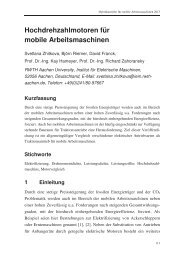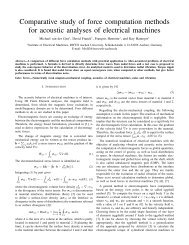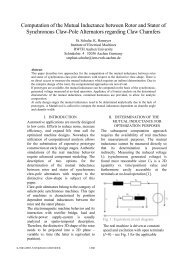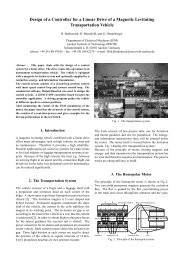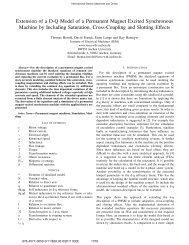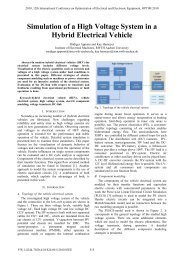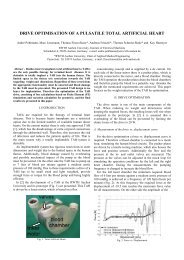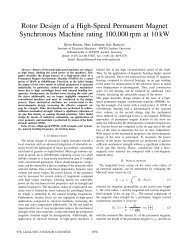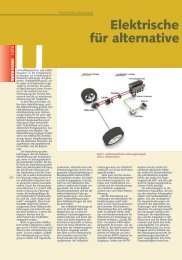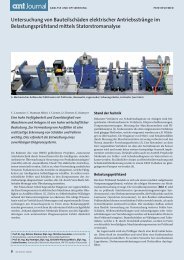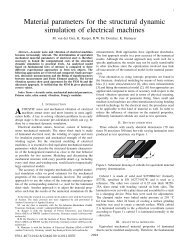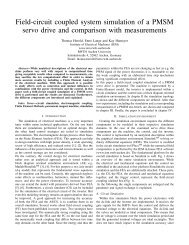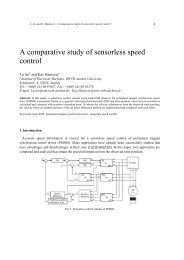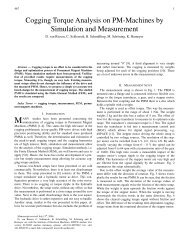Improvement of a Non-Contact Elevator Guiding System by ...
Improvement of a Non-Contact Elevator Guiding System by ...
Improvement of a Non-Contact Elevator Guiding System by ...
Create successful ePaper yourself
Turn your PDF publications into a flip-book with our unique Google optimized e-Paper software.
<strong>Improvement</strong> <strong>of</strong> a <strong>Non</strong>-<strong>Contact</strong> <strong>Elevator</strong><br />
<strong>Guiding</strong> <strong>System</strong> <strong>by</strong> Implementation <strong>of</strong> an<br />
Additional Torsion Controller<br />
Benedikt Schmülling, Peter Laumen, and Kay Hameyer<br />
Institute <strong>of</strong> Electrical Machines, RWTH Aachen University,<br />
Schinkelstraße 4, D-52056 Aachen, Germany<br />
phone: (+49)-241-80-97667, fax: (+49)-241-80-92270<br />
E-mail: Benedikt.Schmuelling@iem.rwth-aachen.de<br />
Abstract— This paper describes the improvement <strong>of</strong> an electromagnetic<br />
elevator guiding system. Based on an existing system,<br />
which is able to control five spatial degrees <strong>of</strong> freedom <strong>of</strong> an<br />
elevator car, a system enhancement is proposed. The system<br />
<strong>of</strong> five controlled spatial degrees <strong>of</strong> freedom is augmented <strong>by</strong><br />
a sixth degree <strong>of</strong> freedom: This is the elevator car’s vertical<br />
torsion angle. Contrary to the former system, it is not longer<br />
a precondition, that the elevator car is a rigid body or the<br />
manufacturing tolerances in very high buildings are almost<br />
zero. Therefore, the system presented is more realistic than<br />
its antecessor. The present paper describes the derivation <strong>of</strong><br />
the additional torsion controller and compares the two unequal<br />
systems. Benefits and disadvantages <strong>of</strong> the augmented system are<br />
specified and evaluated.<br />
Index Terms— Electromagnetic actuator, elevator test bench,<br />
force decoupling, guideway transportation, linear guiding system,<br />
magnetic levitation (maglev), mechatronics, modeling, motion<br />
control, simulation<br />
I. INTRODUCTION<br />
Nowadays, more and more high-rise buildings are constructed<br />
in Asia and other parts <strong>of</strong> the world. A high requirement<br />
to these buildings is the design <strong>of</strong> the traffic infrastructure<br />
within. The focus on improvements <strong>of</strong> the buildings’ transportation<br />
systems rests on the elevator systems since the design<br />
<strong>of</strong> such a system for very high buildings is always a design<br />
near a technical threshold range. Additionally, new elevators<br />
have to be comfortable and have to possess low-maintenance.<br />
A proposal for a faster but wear-resistant traffic system in<br />
high buildings is the employment <strong>of</strong> electromagnetic guides<br />
to elevators. These systems promise faster passenger transportation<br />
due to the frictionless operation and at least the<br />
same riding comfort as state <strong>of</strong> the art elevator systems due to<br />
the absent contact between slider and guide rail. In addition,<br />
these guideways have no consumption <strong>of</strong> lubricants, which is<br />
a further advantage compared to mechanical guideways. In<br />
former works (e.g. [1] and [2]), the assembling and operation<br />
<strong>of</strong> an elevator test bench is presented, which shows a well<br />
running system. The introduced system demonstrates an electromagnetic<br />
guiding system controlling five <strong>of</strong> the six spatial<br />
degrees <strong>of</strong> freedom (DOF) which are depicted in Figure 1.<br />
The elevator car is assumed to be a rigid body. It is fixed in<br />
one DOF <strong>by</strong> its propulsion device, which is a rope in this<br />
Fig. 1. Arrangement <strong>of</strong> the actuators on the elevator car (left hand side) as<br />
well as their actuating forces and the elevator’s DOF (right hand side).<br />
case. This is the DOF in vertical z-direction. The other five<br />
DOF are the translatory movements in x- and y-directions<br />
and the rotary movements α, β, and γ around the axes <strong>of</strong> a<br />
Cartesian coordinate system located at the center <strong>of</strong> gravity<br />
<strong>of</strong> the elevator car. A DOF control system is created to<br />
stabilize the elevator car. Measurements during the test bench<br />
operation show a good system response to disturbance forces.<br />
However, the assumption to behave like a rigid body seems<br />
to be not reasonable for an elevator car. Usually, elevator<br />
cars are manufactured in lightweight construction to minimize<br />
the entire mass, which has to be moved. This also counts<br />
for electromagnetic guided elevators. Thus, the elevator car<br />
will not behave like a rigid body and five DOF are not<br />
adequate to describe its spatial motion. The aim <strong>of</strong> the present<br />
work is to improve the electromagnetic guiding system <strong>by</strong><br />
introducing a torsion controller that eliminates an angular<br />
deviation around the vertical z-axis <strong>of</strong> ro<strong>of</strong> and floor <strong>of</strong> the<br />
elevator car. This deviation is described as a further DOF<br />
χ. The expectation <strong>of</strong> reducing displacement in this DOF is<br />
to lower the requirements to manufacturing tolerances <strong>of</strong> the
y<br />
x<br />
winding<br />
air gaps<br />
guide rail<br />
ΦEl ΦP M<br />
permanent<br />
magnets<br />
ride direction FωAx<br />
Fig. 2. Flux in an ω-actuator’s cross-section.<br />
sensor<br />
ω-actuator<br />
DC/DCconverters<br />
galvanic<br />
separation<br />
chassis<br />
ω-actuator<br />
safety bearing<br />
peripheral power supply<br />
Fig. 3. <strong>Elevator</strong> test bench.<br />
rope<br />
elevator’s rails and <strong>of</strong> the elevator car.<br />
A. Actuators<br />
power supply for<br />
sensors<br />
II. GUIDING TOPOLOGY<br />
actuator’s yoke<br />
FωAy<br />
sensor<br />
safety<br />
bearing<br />
ω-actuator<br />
sensor<br />
ω-actuator<br />
An important component <strong>of</strong> the guideway is the so called<br />
guiding shoe, which transmits disturbance forces from the<br />
elevator car to the guide rail. As aforementioned, conventional<br />
guiding shoes are constructed using rollers or slideways.<br />
The electromagnetic alternative presented is the actuator in<br />
ω-shape [3]. This ω-actuator is an electromagnetic actuator<br />
able to excite three independent pulling forces. This is a<br />
significant improvement with respect to conventional u-shaped<br />
actuators [4], which generate a pulling force in one direction<br />
only. Therefore, one ω-actuator replaces three u-actuators. A<br />
further actuator is the magnet module presented in [5], which<br />
controls one complete DOF, i.e. producing a force in one<br />
direction (positive and negative). Nevertheless, the ω-actuator<br />
controls one and a half DOF. Therewith, two ω-actuators<br />
substitute three magnet modules.<br />
Fig. 2 shows the cross-section <strong>of</strong> an ω-actuator. It consists<br />
<strong>of</strong> a three-armed iron yoke, mounted with permanent magnets<br />
on the outer pole surfaces, and coils around the lateral arms.<br />
The operation <strong>of</strong> this actuator is based on the superposition<br />
<strong>of</strong> a permanent magnet flux ΦP M with an electrically excited<br />
flux ΦEl.<br />
B. Complete <strong>System</strong><br />
The actuators are mounted on opposite edges <strong>of</strong> ro<strong>of</strong> and<br />
floor <strong>of</strong> the elevator car, i. e. four ω-actuators are mounted<br />
on one car. In combination with two guide rails located on<br />
opposite walls <strong>of</strong> the elevator shaft, the complete guiding<br />
system is formed (Fig. 1). Altogether, the four ω-actuators<br />
produce twelve pulling forces, organised in pairs along six<br />
action lines. Hence, a total <strong>of</strong> six forces remain to control the<br />
position <strong>of</strong> the elevator car, i. e. to control all spatial degrees<br />
<strong>of</strong> freedom except the elevator’s driving force. These forces<br />
are depicted in Fig. 1 as well. Fig. 3 presents a test bench <strong>of</strong><br />
the electromagnetic guides elevator.<br />
C. The Test <strong>System</strong>’s Optimization Potential<br />
In a first step, the stiffness <strong>of</strong> the chassis is assumed to<br />
be quite high (the compliance is assumed to be zero); a<br />
deformation due to the electromagnetic forces <strong>of</strong> the actuating<br />
electromagnets is not expected. Hence, it is assumed, that the<br />
measuring <strong>of</strong> five local positions is sufficient for a complete<br />
position determination <strong>of</strong> the elevator car. The five local<br />
positions measured are three times the actuators’ air gaps in<br />
x-direction (at position <strong>of</strong> forces F1, F2, and F3 corresponding<br />
to Fig. 1) and two times the air gaps in y-direction (at position<br />
<strong>of</strong> forces F5 and F6 corresponding to Fig. 1). The operation<br />
<strong>of</strong> this test bench demonstrates a running system, but an<br />
observing <strong>of</strong> the air gaps at the local position x4 (at position<br />
<strong>of</strong> force F4 in Fig. 1) reveals a deviation to the ideal position.<br />
Fig. 4. Displacement <strong>of</strong> one actuator in x-direction measured <strong>by</strong> air gap<br />
sensor x4 during the elevator’s ride.
Fig. 4 presents the measured position x4 during a ride <strong>of</strong> the<br />
elevator car from top to bottom <strong>of</strong> its shaft. It can be seen,<br />
that the the local actuator is not centered in its x-position<br />
but changes the value <strong>of</strong> its displacment during movement<br />
in z-direction. The other three actuators do not show this<br />
deviation when the elevator rides. This effect demonstrates<br />
that the elevator car is twisted and therefore not comparable<br />
to a rigid body or the manufacturing tolerances <strong>of</strong> the guide<br />
rails are higher than expected. However, the capturing <strong>of</strong> five<br />
sensor signals is not sufficient.<br />
D. Utilizing the sixth sensor signal<br />
In a first step, it is investigated, which influence on the<br />
existing system, containing five controlled DOF (5 DOF<br />
mode, as described in [6]), the capturing and utilizing <strong>of</strong> the<br />
additional x4 sensor signal has. In [7] can be read, how the<br />
five DOF are calculated <strong>by</strong> five sensor signals. The calculation<br />
procedure is a coordinate transformation from the measured air<br />
gaps into the global DOF. To utilize the sixth sensor signal an<br />
augmented transformation matrix T is introduced:<br />
T =<br />
2<br />
6<br />
4<br />
1/4 0 1/4 1/4 0 1/4<br />
0 1/2 0 0 1/2 0<br />
0 −1/dz 0 0 1/dz 0<br />
1/2dz 0 1/2dz −1/2dz 0 −1/2dz<br />
−1/2dy 0 1/2dy −1/2dy 0 1/2dy<br />
3<br />
7<br />
5 , (1)<br />
with dy as the horizontal distance and dz as the vertical distance<br />
between two ω-actuators. The coordinate transformation<br />
is performed as follows:<br />
q = T · δsensor, (2)<br />
where q is the position vector <strong>of</strong> the elevator car containing<br />
all five DOF<br />
q = (x y α β γ) T<br />
(3)<br />
and δsensor is the vector <strong>of</strong> the six sensor signals<br />
δsensor = (x1 y1 x2 x3 y3 x4) T . (4)<br />
However, this transformation matrix for utilizing the sensor<br />
signal x4 is not the final solution. It can be seen, that T is<br />
a 6x5 matrix. Therefore, the DOF are exactly determined <strong>by</strong><br />
the local air gap sensor signals, but on the other side there<br />
is an infinite number <strong>of</strong> solutions for the air gap heights <strong>by</strong><br />
given DOF. The system is under-determined. This means, if<br />
all DOF are controlled to zero, the local air gaps need not<br />
Fig. 5. The four measured signals <strong>of</strong> the air gaps in x-direction during the<br />
elevator’s ride.<br />
to be in the central position. In theory, also an impact <strong>of</strong> the<br />
actuators on the guide rails is possible. The result <strong>of</strong> a system<br />
observed and controlled in the way described is presented in<br />
Fig. 5. It can be seen, that the four air gaps do not posses<br />
their reference value (0 mm), which would mean that the ωactuators<br />
are staying in a central x-position around the guide<br />
rails. Instead <strong>of</strong> that, they are moving in every moment to the<br />
position, which provides the system’s lowest energetic state. To<br />
avoid an undefined system behavior and to avoid the posibility<br />
<strong>of</strong> impacts a full defined system model has to be obtained.<br />
E. DOF Augmentation<br />
If the elevator test bench shall demonstrate a realistic elevator<br />
system, a sixth measured and controlled DOF is essential.<br />
Therefore, the elevator’s torsion angle χ is introduced, which<br />
is calculated <strong>by</strong> the further augmented transformation matrix<br />
T6D:<br />
T6D =<br />
2<br />
6<br />
4<br />
1/4 0 1/4 1/4 0 1/4<br />
0 1/2 0 0 1/2 0<br />
0 −1/dz 0 0 1/dz 0<br />
1/2dz 0 1/2dz −1/2dz 0 −1/2dz<br />
−1/2dy 0 1/2dy −1/2dy 0 1/2dy<br />
−1/dy 0 1/dy 1/dy 0 −1/dy<br />
The coordinate transformation <strong>of</strong> the full determined system<br />
is performed as follows:<br />
3<br />
7<br />
5<br />
(5)<br />
q6D = T6D · δsensor, (6)<br />
where q6D is the position vector <strong>of</strong> the elevator car containing<br />
all six DOF<br />
q6D = (x y α β γ χ) T . (7)<br />
Fig. 6 presents the resulting uncontrolled torsion angle during<br />
operation in 5 DOF mode. As presented, the angle χ is unequal<br />
to zero for the most time.<br />
In addition to the augmented sensor signal transformation<br />
matrix, the force transformation matrix and the current transfomation<br />
matrix (introduced in [1]) have to be augmented as<br />
well.<br />
The force transformation matrix, which transforms the local<br />
actuator forces into the global forces and torques, results as<br />
Fig. 6. Uncontrolled torsion angle χ calculated <strong>by</strong> the measurement results<br />
<strong>of</strong> four air gap sensors during the elevator’s ride.
follows:<br />
⎛<br />
⎜<br />
⎝<br />
=<br />
˜Fx<br />
˜Fy<br />
˜Mα<br />
˜M β<br />
˜Mγ<br />
˜Mχ<br />
2<br />
6<br />
4<br />
⎞<br />
⎟<br />
⎠<br />
1 0 1 1 0 1<br />
0 1 0 0 1 0<br />
0 −dz /2 0 0 dz /2 0<br />
dz /2 0 dz /2 −dz /2 0 −dz /2<br />
−dy /2 0 dy /2 −dy /2 0 dy /2<br />
−dy /2 0 dy /2 dy /2 0 −dy /2<br />
Global values are tagged <strong>by</strong> the ∼-symbol. The here introduced<br />
sixth row describes the transformation from local forces<br />
(F1, F2, F3, F4, F5, and F6) to the torsional moment ˜ Mχ.<br />
The current transformation matrix describes the transformation<br />
from virtual global quantities to local coil currents. Due<br />
to an augmention to an 8x8 matrix described in [1] the<br />
transformation for χ is still implemented, e.g. compare ˜ Θh3<br />
in [1] with Ĩχ below:<br />
⎛ ⎞<br />
⎛ ⎞<br />
⎜<br />
⎝<br />
Ĩx<br />
Ĩy<br />
Ĩα<br />
Ĩβ<br />
Ĩγ<br />
Ĩχ<br />
Ĩ h1<br />
Ĩ h2<br />
⎟<br />
⎠ =<br />
2<br />
6<br />
4<br />
1 −1 −1 1 1 −1 −1 1<br />
1 1 −1 −1 1 1 −1 −1<br />
−1 −1 1 1 1 1 −1 −1<br />
1 −1 −1 1 −1 1 1 −1<br />
−1 1 −1 1 −1 1 −1 1<br />
−1 1 −1 1 1 −1 1 −1<br />
1 1 1 1 1 1 1 1<br />
1 1 1 1 −1 −1 −1 −1<br />
3<br />
7<br />
5<br />
⎛<br />
⎝<br />
3<br />
7<br />
5<br />
⎜<br />
⎝<br />
F 1<br />
F 5<br />
F 2<br />
F 3<br />
F 6<br />
F 4<br />
⎞<br />
⎠<br />
I 1l<br />
I 1r<br />
I 2l<br />
I 2r<br />
I 3l<br />
I 3r<br />
I 4l<br />
I 4r<br />
Based on these adjustments the control design is explaind in<br />
detail in the following section.<br />
III. 6TH DOF CONTROL UNIT DESIGN<br />
The former sections describe the necessity <strong>of</strong> a torsion<br />
controller. With an approval <strong>of</strong> a torsional deformation <strong>of</strong> the<br />
elevator car and with an observation <strong>of</strong> the tosion, a further<br />
equation to describe and model the system behavior has to be<br />
obtained. Due to a high torsional stiffnes around x-axis and<br />
y-axis and due to the larger dimensions <strong>of</strong> the elevator car in<br />
z-direction, only the torsianal deformation around the z-axis<br />
is analyzed<br />
A. Torsion Equations<br />
Before deriving the torsion’s equations two important predefinitions<br />
are made:<br />
• The main part <strong>of</strong> the mass is placed in the ro<strong>of</strong> and the<br />
floor <strong>of</strong> the elevator’s chassis.<br />
• The ro<strong>of</strong> and floor <strong>of</strong> the chassis are rigid. Thus, the<br />
compliance is located in the walls.<br />
Due to these assumptions the torsion is modeled as a massspring<br />
oscillator [8] and the torsion is described <strong>by</strong> the angular<br />
torsion displacement between ro<strong>of</strong> and floor.<br />
(8)<br />
⎟<br />
⎠<br />
(9)<br />
χ = φtop − φbottom. (10)<br />
Ro<strong>of</strong> and floor are comparable to the oscillating mass, the<br />
chassis’ wall is comparable to the tosion’s spring. Hooke’s<br />
law delivers the oscillation differential equation<br />
Mχ − c · χ = Jχ ¨χ, (11)<br />
with Jχ as the torsion oscillation’s moment <strong>of</strong> inertia and c<br />
as the stiffness <strong>of</strong> the chassis. To define the stiffness <strong>of</strong> the<br />
chassis, an excurse to mechanics <strong>of</strong> materials is performed.<br />
The chassis’ wall is idealized in its resistance contrary to<br />
an acting torsion moment as a hollow pr<strong>of</strong>ile. That means,<br />
it is described as a thin-walled self contained cross-section.<br />
A torsional load is affiliated <strong>by</strong> shear that acts in this crosssection.<br />
The twist <strong>of</strong> a pr<strong>of</strong>ile with length h and under impact <strong>of</strong> the<br />
torsion moment MT around the z-axis is defined as<br />
χ = MT · h<br />
. (12)<br />
G · IT<br />
G is the shear module, which describes the characteristic <strong>of</strong><br />
the material under a shear load, IT is the tosion’s moment <strong>of</strong><br />
inertia, which describes the influence <strong>of</strong> the pr<strong>of</strong>ile geometry<br />
on the torsional stiffness. According to this, the differential<br />
torsion equation is derived as follows:<br />
Mχ = Jχ ¨χ +<br />
G · IT<br />
h<br />
B. Derivation <strong>of</strong> the State Space Equations<br />
· χ. (13)<br />
The derivation <strong>of</strong> the state space equations [9] for the spatial<br />
DOF is the same as described in [1], [7], and [2]. Therefore,<br />
in this section the derivation <strong>of</strong> the state space equations for<br />
the additional DOF χ is presented in detail.<br />
The mathematical modeling bases on the deduced differential<br />
equations. The state variables are the angular position χ and<br />
the angular speed ˙χ. These quantities are deviation quantities,<br />
this means they describe the deviation to the reference position<br />
and the reference speed respectively. To avoid a permanent<br />
deviation, the integral <strong>of</strong> the angular position � χdt is added<br />
to the state variables:<br />
⎛<br />
χ = ⎝<br />
� χdt<br />
χ<br />
˙χ<br />
⎞<br />
⎠ . (14)<br />
Equation 8 expresses the torsional moment with the local<br />
quantities <strong>of</strong> the guiding system, the corresponding air gaps.<br />
Including the applied torque and the linearized force equations<br />
follows<br />
˜Mχ(∆xi) = dy·(−Fδx·∆x1+Fδx·∆x2+Fδx·∆x3−Fδx·∆x4),<br />
(15)<br />
with ∆xi as the respective deviation to the desired air gap<br />
value and Fδx as the linearization factor <strong>of</strong> the local forces in<br />
x-direction. After transformation to global quantities results<br />
˜Mχ(χ) = dy · (dy · Fδx · χ). (16)<br />
With equation 13 for the angular acceleration follows<br />
¨χ(χ) = 1<br />
Jχ<br />
· (d 2 G · IT<br />
y · Fδx − )χ. (17)<br />
Due to the dependancy <strong>of</strong> the torsional moment on the coil<br />
currents (I1l to I4r) follows<br />
˜Mχ(Ii) = FIxl·(I1l+I2l−I3l−I4l)+FIxr·(I1r+I2r−I3r−I4r),<br />
(18)<br />
dz
with FIxl and FIxr as further linearization factors <strong>of</strong> the local<br />
forces in x-direction.<br />
The transformation to global quantities yields<br />
˜Mχ( Ĩχ, Ĩh2) = FIxl · ( 1<br />
2 Ĩχ + 1<br />
2 Ĩh2) + FIxr · (− 1<br />
2 Ĩχ + 1<br />
2 Ĩh2).<br />
(19)<br />
With FIxl = −FIxr results<br />
˜Mχ( Ĩχ) = FIxl · Ĩχ. (20)<br />
Finally, for the acceleration in dedendancy to current Ĩχ<br />
follows<br />
¨χ( Ĩχ) = d2 y<br />
Jχ<br />
· FIxl · Ĩχ. (21)<br />
The state space equation <strong>of</strong> DOF χ results in<br />
⎡<br />
⎛ ⎞ 0<br />
χ ⎢<br />
⎣ 0<br />
⎝ ˙χ ⎠ =<br />
0<br />
¨χ<br />
� �� �<br />
˙χ<br />
1<br />
0<br />
d<br />
0<br />
1<br />
2<br />
y<br />
Jχ · Fδx − G·IT<br />
�<br />
dz·Jχ<br />
��<br />
Aχ<br />
⎡<br />
⎢<br />
⎣<br />
+<br />
⎤<br />
⎛ � ⎞<br />
⎥<br />
⎦ · χdt<br />
⎝<br />
0<br />
χ ⎠<br />
� ˙χ<br />
� �� �<br />
χ<br />
0<br />
0<br />
d 2<br />
�<br />
⎤<br />
⎥<br />
⎦ · Ĩχ<br />
y<br />
·<br />
����<br />
FIx Jχ u<br />
�� �<br />
and<br />
y = (0 1 0) · ⎝<br />
� �� �<br />
cχ<br />
⎛<br />
bχ<br />
� χdt<br />
χ<br />
˙χ<br />
⎞<br />
(22)<br />
⎠ . (23)<br />
Here, Fδx and FIx are linearization factors. These two equations<br />
are the description <strong>of</strong> the uncontrolled system. Aχ is the<br />
system matrix, bχ the input vector, and cχ the output vector.<br />
The feedthrough value dχ is chosen to be zero, since there is<br />
no direct feedthrough in a real system. Here, y is the output<br />
value <strong>of</strong> the state space system and not the DOF y.<br />
C. Control Parameters<br />
Due to the eigenvalues located on the imaginary axis the<br />
system is instable. The eigenvalues are placed <strong>by</strong> feedback <strong>of</strong><br />
the state space vector and combination with the input vector.<br />
For feedback the vector k is deployed, which contains a factor<br />
for each state variable. The controlled system is described as<br />
follows:<br />
˙χ = Aχ · χ + bχ · u (24)<br />
u = −k · χ . (25)<br />
u is the input value, χ is the state vector, and k is the feedback<br />
vector.<br />
Both equations deliver the new system matrix Ak<br />
Ak = Aχ − bχ · χ. (26)<br />
This augmented operation <strong>of</strong> the elevator guiding system with<br />
six controlled DOF is called 6 DOF mode.<br />
Fig. 7. Torsion angle χ calculated <strong>by</strong> the measurement results <strong>of</strong> four air gap<br />
sensors during switching the systems operation mode from five DOF control<br />
to six DOF control.<br />
Fig. 8. Controlled torsion angle χ calculated <strong>by</strong> the measurement results <strong>of</strong><br />
four air gap sensors during the elevator’s ride.<br />
IV. MEASUREMENTS<br />
In a first measurement, the elevator guiding system directly<br />
switches from 5 DOF mode to 6 DOF mode. Fig. 7 presents<br />
the switching process response <strong>of</strong> torsion angle χ. It can be<br />
seen, that the deviation to the desired value χ = 0 amounts<br />
approximately ∆χ = 1.5 mrad at time t = 0 s. The hard<br />
switching to 6 DOF mode occurs after approximately t = 1.8 s<br />
measurement. The controlled variable χ shows fast motion to<br />
the desired value inclusive a transient oscillation, which lasts<br />
a few seconds. This oscillation depends on the control action<br />
<strong>of</strong> the other five DOF controllers. Every controller works<br />
completely independent, but influences each other in a real<br />
system. To avoid a disturbing <strong>of</strong> the five spatial DOF and to<br />
provide smooth and silent operation <strong>of</strong> the elevator car, the<br />
χ-controller is much slower than the other five controllers.<br />
Also during the elevator car’s ride through the elevator shaft,<br />
the guiding system shows a robust system behavior in 6 DOF<br />
mode. Fig. 8 presents the torsion angle χ when the elvator car<br />
rides from top to bottom <strong>of</strong> its shaft. In difference to 5 DOF<br />
mode operation, presented in Fig. 6, χ remains on its reference<br />
position. Very small deviations are compensated quite fast.<br />
Furthermore, the ω-actuators remain in their desired position.<br />
This is evaluated <strong>by</strong> measuring the respective air gap lengths<br />
x1, x2, x3 and x4. The result, which shows the four air gap<br />
sensor signals during the whole ride in vicinity <strong>of</strong> reference<br />
value zero is shown in Fig. 9. It can be seen, that all actuators
Fig. 9. The four measured signals <strong>of</strong> the air gaps in x-direction during the<br />
elevator’s ride in 6 DOF mode.<br />
Fig. 10. The six measured DOF exited with an impulse in x-direction on<br />
the floor <strong>of</strong> the elevator’s chassis.<br />
stay in the desired central x-position around the guide rails<br />
(x = 0). The risk <strong>of</strong> an actuator’s impact on the guide rails is<br />
averted.<br />
In final measurements, the functionality <strong>of</strong> the entire guiding<br />
system in 6 DOF mode is investigated. During operation, the<br />
system is excited <strong>by</strong> external force impulses on the elevator<br />
car’s chassis in several directions. As an example, the force<br />
impact in x-direction on the floor <strong>of</strong> the elevator car is<br />
presented. Fig. 10 shows the excitation response <strong>of</strong> all DOF.<br />
As displayed, all six DOF show an impact response and a fast<br />
disturbance compensation. However, that all DOF controllers<br />
show a reaction is a reasonable result. On the one hand,<br />
the force impulse was not exerted to the barycenter <strong>of</strong> the<br />
elevator car. Due to this, all spatial DOF are excited as well.<br />
Furthermore, the actuators moved out <strong>of</strong> their desired position.<br />
This produces additional magnetic forces to the actuators<br />
and herewith to the elevator car’s chassis, which leads to a<br />
deformation (torsion) <strong>of</strong> the elevator car. After a period <strong>of</strong><br />
t ≈ 1 s all DOF deviations are compensated and the DOF are<br />
back in their desired position. The entire system works similar<br />
to its antecessor system and the additional torsion controller<br />
has no negative influence to the control quality <strong>of</strong> the other<br />
five DOF controller.<br />
V. CONCLUSION<br />
A test bench for the validation <strong>of</strong> an electromagnetic guiding<br />
system for elevator cars is introduced. Advances <strong>of</strong> a contactless<br />
guided elevator system are detailed in the beginning.<br />
Thereafter, the design <strong>of</strong> the elevator test bench is explaind.<br />
Starting with the special kind <strong>of</strong> actuator implemented to the<br />
elevator car, the complete system setup is presented. After<br />
this, the disadvanteges <strong>of</strong> the actual state <strong>of</strong> system, described<br />
in former publications, are declared. These are the systems<br />
inability to compensate manufacturing tolerances as well as<br />
the unrealistic assumption to model the elevator car as a rigid<br />
body. The disadvantages <strong>of</strong> the former system are proven<br />
and illustrated <strong>by</strong> measurement results. It is shown, that a<br />
system augmentation from five DOF to six DOF may avoid<br />
the disadvatages presented.<br />
Furthermore, an implementation <strong>of</strong> an additional torsion controller,<br />
to the guiding system for the compensation <strong>of</strong> manufacturing<br />
tolerances in realistic systems is described. An approach<br />
for the modeling <strong>of</strong> this additional DOF is exemplified as<br />
well. Subsequently, the derivation <strong>of</strong> the torsion controller is<br />
declared in detail.<br />
Finally, the improved system behavior is depicted. Measurements<br />
<strong>of</strong> the air gap sensor signals as well as the new DOF χ<br />
shows a constant abidance on their reference position only<br />
in the new augmented control mode, the so-called 6 DOF<br />
mode. One measurement shows the entire system excited <strong>by</strong><br />
external impacts in several directions. The system’s response<br />
is investigated and it is demonstrated that the additional<br />
torsion controller only has a low influence to the other<br />
DOF controllers. Altogether, the measurement results show<br />
a robust state-space controller with a high control quality. The<br />
described disadvatages <strong>of</strong> the former system are compensated<br />
<strong>by</strong> the augmented guiding system.<br />
REFERENCES<br />
[1] B. Schmülling, R. Appunn, and K. Hameyer, “Electromagnetic guiding<br />
<strong>of</strong> vertical transportation vehicles: state control <strong>of</strong> an over-determined<br />
system,” in XVIII International Conference on Electrical Machines.<br />
Vilamoura, Portugal: ICEM, September 2008.<br />
[2] R. Appunn, B. Schmülling, and K. Hameyer, “Electromagnetic guiding<br />
<strong>of</strong> vertical transportation vehicles: Experimental evaluation,” IEEE Transactions<br />
on Industrial Electronics, vol. 57, no. 1, pp. 335–343, January<br />
2010.<br />
[3] M. Morishita and M. Akashi, “Electromagnetic non-contact guide system<br />
for elevator cars,” in The Third International Symposium on Linear Drives<br />
for Industry Applications. Nagano, Japan: LDIA, October 2001, pp. 416–<br />
419.<br />
[4] B. Schmülling, O. Effing, and K. Hameyer, “State control <strong>of</strong> an electromagnetic<br />
guiding system for ropeless elevators,” in European Conference<br />
on Power Electronics and Applications. Aalborg, Denmark: EPE,<br />
September 2007, pp. 1–10.<br />
[5] A. Schmidt, C. Brecher, and F. Possel-Dölken, “Novel linear magnetic<br />
bearings for feed axes with direct drives,” in International<br />
Conference on Smart Machining <strong>System</strong>s at the National Institute<br />
for Standards and Technology. Gaithersburg, MD, USA:<br />
www.smartmachiningsystems.com, March 2007.<br />
[6] B. Schmülling, R. Appunn, F. Wikullil, and K. Hameyer, “Design and<br />
operation <strong>of</strong> an electromagnetically guided elevator test bench,” in The<br />
7th International Symposium on Linear Drives for Industry Applications.<br />
Incheon, Korea: LDIA, September 2009.<br />
[7] B. Schmülling, Elektromagnetische Linearführungen für Aufzugsysteme.<br />
Aachener Schriftenreihe zur Elektromagnetischen Energiewandlung,<br />
Band 8: Shaker Verlag, 2009, Dissertation, RWTH Aachen University.<br />
[8] D. J. Ewins, Modal Testing: Theory, Practice and Application. Baldock:<br />
Research Studies Press LTD., 2000.<br />
[9] D. Li and H. Gutierrez, “Observer-based sliding mode control <strong>of</strong> a 6d<strong>of</strong><br />
precision maglev positioning stage,” in 34th Annual Conference <strong>of</strong><br />
Industrial Electronics. Orlando, Florida, USA: IEEE IECON 2008,<br />
November 2008, pp. 2562–2567.



